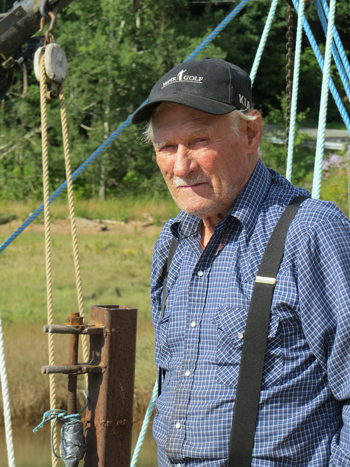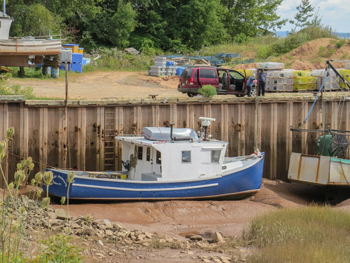Glanville Travis
One Fisherman’s Opinion
by Sandra Dinsmore

Loading a plane with live lobster at Gateway Airfreight Facilities, Halifax, Nova Scotia. An aircraft pallet holds from 120 to 160 boxes of live lobster, depending on where it fits in the aircraft. Each box holds from 8 to 14 lobsters, depending on size. Richard Stern photo
Glanville Travis has been fishing the difficult waters of Nova Scotia’s Minas Basin for 42 years. A lean 5 feet 8 1/2 with appropriately wind and weatherworn face and hands, the 78-year-old sports a white moustache and a two-day beard, and uses suspenders rather than a belt to hold up his trousers.
For some years Travis worked ashore for the athletic department of Acadia University in nearby Wolfville, only a few miles from Canning where Travis raised his three children and still lives. But in the end he said, “Mother Nature seemed to be [the boss] I went for because when decisions were made between her and I, that way we had no argument. She let me do what I wanted to do.”
Mother Nature may have let Travis do what he wanted to do, but she didn’t make it easy for him or for any Fundy fisherman.
The Fundy basin resulted from the pulling apart of continental plates that formed the Atlantic Ocean some 200 million years ago, according to a notice posted by a bridge over the Cornwallis River in Wolfville.
The notice states that it’s the shape of the Bay of Fundy that is largely responsible for its incredible high tides. “The incoming tides rush with powerful force up the long funnel of the Bay of Fundy into the Minas Basin forming tidal waves at the head of the basin in the rivers like the Cornwallis.”
Although some areas of the Bay of Fundy have enough water for boats at low tide, Travis, fishing in the challenging, ever-moving waters of the Minas Basin, explained, “Where we fish, our tide leaves the wharf and recedes back about a mile or a mile and a quarter. You’re sitting on a mud bank. Before you can get any water, you’re a mile from it.
“We have a rise and fall of tide in the Minas Basin of 42 feet,” he reported. “From dead low water to high water takes six hours to come in and it raises an average of seven feet an hour.”
Asked if he can fish any time of day and tide, Travis replied, “When the buoys start showing, that’s when we start pulling.” (He uses wood or Styrofoam buoys on his single trap lines. He uses the big inflatable balloons on each end of his trawls, but says a PVC or jet buoy shows a little earlier than wood or Styrofoam because it doesn’t drag as much water.)
“When you set a trawl,” he explained, “you put a 300 lb. trap on the end and 150s and 200s in between depending on where you are in the current. We can tell by the depth of the cement in the trap how much they weigh. Probably half of our traps weigh 150. Some of our end traps, instead of putting a trap down we’ll put a big anchor on it. We do that because if the tide starts to run, and you’re on the first buoy of the line, you can get ten more traps before they run under.” In a massive understatement, he said of fishing in the Bay of Fundy’s intense Midas Basin, “It’s an altogether different ballgame.”

The stern of Glanville Travis’ boat far right. The boat behind Glanville Travis’ boat at what must be close to high tide. Richard Stern photo
The Fundy fisherman used the difference between hooking a wild salmon and hooking a pen-fed one as a metaphor for the difference between Canadian and Maine lobster. “The wild salmon has the vigor to stay alive,” he said; “raised salmon can’t fight. You cannot take something and feed it by hand so that it doesn’t have to look after itself and then make it responsible for its own well-being. It starts to learn survival skills as soon as it’s born, but if it’s in a pen and hand-fed …” he paused a moment and then said, “It’s the same as a Maine lobster.” Of the lobsters where he fishes, he said, “I know there are a lot of Maine stock.” And he says he can tell the difference between a wild Canadian lobster and a Maine one, saying, “A Maine lobster that’s been [raised] in a hatchery hasn’t got the instinct of a wild lobster.”
Travis is far from the first fisherman to speak of what many refer to as open ocean farming, for the way sublegal lobster nip in and out of the many baited traps lining the Maine bottom and fill themselves on soft herring instead of having to fight for their food.
In Travis’s view a lot of lobster spawned in the Minas Basin (LFA 35) go down the Bay of Fundy as larvae because the waters travel a mile a day further on the outgoing tide than they come back on the flood. “So if you have no wind,” he said, “[this larva] is going to drift. In the time 90 days is up, [that larva] is down off Maine.” (This, Travis thinks, is where the Minas Basin larva starts being essentially “pen fed” and loses the fighting instinct it was born with.)
“All of a sudden [this larva] get a little weight and he goes to the bottom and says, I’ll go back where I came from, so he comes up the New Brunswick side into the Minas Basin.” But Travis maintains that the larva comes back a tame “Maine lobster” rather than a wild Minas Basin one. (There are only 99 licenses in LFA 35 and each license holder can only fish 300 traps versus the millions in Maine waters.)
With waters as powerful as this, it’s amazing that anyone can fish them at all. People who fish the Minas Basin can haul traps for two hours prior to high tide and the one hour of slack tide. As Travis said, “If we could pull traps eight to ten hours a day, there’d be no fish left. So Mother Nature has another way of saying, I’m going to help with conservation.”
